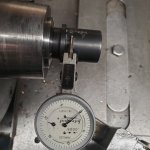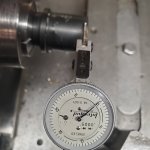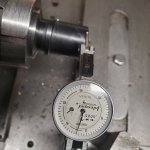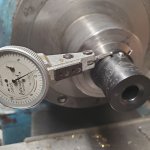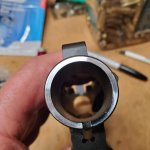something’s wrong with me…this thread must’ve given me a TBI…I read it like thisI've already started laughing myself into a nut job
Join the Hide community
Get access to live stream, lessons, the post exchange, and chat with other snipers.
Register
Download Gravity Ballistics
Get help to accurately calculate and scope your sniper rifle using real shooting data.

Install the app
How to install the app on iOS
Follow along with the video below to see how to install our site as a web app on your home screen.
Note: This feature may not be available in some browsers.
You are using an out of date browser. It may not display this or other websites correctly.
You should upgrade or use an alternative browser.
You should upgrade or use an alternative browser.
Barrel Torque Ludicrocity
- Thread starter Ronin22
- Start date
See i told you it's startingsomething’s wrong with me…this thread must’ve given me a TBI…I read it like this
Mike
Honest to god I couldn't tell if you were being sarcastic about those torque values. About how much torque does it take to break an action wrench and is that the limiting factor on how much most people can torque a barrel on or is it damage to the action caused by the wrench?See i told you it's starting
lol
Mike
Well I talked with Mike on the phone and apparently those torque numbers are legit. Got some cool info on some other aspects of riflebuilding too which was fun (and a cool book recommendation as well).
No...So a jam nut at 55ftlbs is imparting more/equal torque on the barrel nut face and receiver face than a 100ftlbs shouldered prefit?
The jam nut on a prefit is even different than a nut pushing back on the barrel extension ring.
Everything should be perfectly square as possible...or the barrel is pulled off center as tbe slack in the threads take up torque on an uneven surface or just jammed by the nut alone in the case of a barrel nut in different applications.
Why suppressors & some muzzle breakes do not recommend crush washers, or jam nuts ...but direct timmed mounts or precision shims so baffle strikes don't happen.
On ARs I always square, glue in, and torque to 60 ft/lbs never less, and never more on aluminum threads saved by the hard anodizing and applied anti-seeze
And mill a slot if the barrel nut groove does not line up for the gas tube and some use a steel nut that does not require lining up a slot.
Factory installed barrel extension butted up against a supposed factory square shoulder.
Scrapped the glue off this pre installed barrel in one area to get a reading straight across the length of the extension
Its pretty close to zero- zero, and .0002" TIR on tbe barrel itself...
but the runout on the end of the barrel extension is .002" and the face around. 001". Imagine your 16" barrel is attached pointing down range at a slight angle.
Plus any reciever portion out of square, or the barrel nut itself.
And thats not all of the problems to address.
Plus ARs flex easily...the best non AR barrel to reciever is mating is the solid receiver directly to barrel shank no barrel nuts, clamping the threads, or set screws...but with precision threads, lubed and torqued to at least 95 plus ft-lbs...IMO
But you all do whatever ya want...maybe a quick change barrel or take down method is more important than best accuracy potential
Attachments
Last edited:
Nah, that’s exactly the way it is loaded.Which is still wrong.
I enjoyed the conversation as well and definitely made a newWell I talked with Mike on the phone and apparently those torque numbers are legit. Got some cool info on some other aspects of riflebuilding too which was fun (and a cool book recommendation as well).
Call anytime it was my pleasure and definitely check that book out you'll learn a couple of interesting things I'm sure...
Mike R
What book?I enjoyed the conversation as well and definitely made a newNINJA friend...
Call anytime it was my pleasure and definitely check that book out you'll learn a couple of interesting things I'm sure...
Mike R
Bottom right, which direction is the force being applied in the red circles when the screw (blue) is tightened?It isn't.
They’re the sane thing rotated 90*Then the arrow in your top drawing shows the force being applied 90 degrees to your bottom drawing. Bottom drawing correct. Top drawing incorrect.
Not if your red circles are to be believed. Section lines would definitely help.They’re the sane thing rotated 90*
The book is called TIGERS REVENGE By Claude Balls it's a great read my NinjaWhat book?
Just playing
Mike R.
Just had a similar conversation on another forum and Harold Vaughn's book was referenced. Oddly enough, the conversation started with scope drop test validity and Aaron Davidson of Gunwerks pointed out issues with the action barrel joint being a variable that isn't corrected for. Quoting his post there on the action/barrel joint:

In turn, he suggested smooth threads and square face is the best way to ensure the joint stays in or returns to the same place.They don't stay locked up. The axial preload you can max without yielding is less than the force generated by the cartridge expansion on firing that is opposite the thread preload.
Last edited:
I for one would agree but what would I knowBut 100lb/ft is, "ludicrous".
Mike R.
Harold Vaughs book was amazing, at least to me (no formal engineering background, just life long shooter, amateur gunsmith). Opened a whole world of possibilities, or at least made me think about a bunch of things that i never considered before.
Any thoughts on the threadform he suggested? The idea being it had a special shape that would allow for a little deformation in the threads, spread the load out more evenly. IE, instead of the first thread carrying say 60% of load, next one 20%, next one 20%, it was more like.... 35/25/15/10/5 (just made up those #s for sake of argument, but the principle i took away was that he was achieving some loading across at least 5 threads, and the difference from one thread to another was much smaller than in typical 60 degree threads....)
My first guess is that, I dont really hear about anyone doing that thread form now, so it either wasn't useful or wasn't useful -enough-
But I also dont know / cant remember the torque values he was going to. (from memory, i think they were on lower end, but *shrugs* been a long time) I suspect that the torque values being discussed here (100lbs or way more) are enough to start causing at least some deformation, even if elastic, and that deformation starts spreading out the load too, even if threadform is conventiional (elastic deformation being the threads flex, but not so much that they dont return to initial shape after load removed). Getting into several hundred lb ft probably starts permanently distorting threads a bit, even though might be hard to see by eye (except for seeing change in surface texture - seeing shiny areas on first thread or two)
It DOES seem like there is a correlation between factory rifles that are known for being out-of-the-box accurate and also that take a ton of torque / heat / cutting shoulder to remove (like tikkas, sakos, hell look at the old steyr SSG69s - that wasn't even threaded, just a temp difference shrinkfit, which was tight enough it needed to be machined out to replace barrel once they had been mated together and temps had equalized). There are lots more, just grabbed a few examples off the top of my head. And to be fair, some of them are employing threadlocker on top of high torque, but, still..... there does seem to be a correlation with good shooting factory guns and barrel / receiver joint that is very tight. Of course there are a thousand things that have to happen to make accurate rifle, just cranking hell out of barrel doesn't ensure success - everything has to be right, or at least in right ballpark (otherwise people would be winning BR championships with old Eddystones and turkish mausers)
Any thoughts on the threadform he suggested? The idea being it had a special shape that would allow for a little deformation in the threads, spread the load out more evenly. IE, instead of the first thread carrying say 60% of load, next one 20%, next one 20%, it was more like.... 35/25/15/10/5 (just made up those #s for sake of argument, but the principle i took away was that he was achieving some loading across at least 5 threads, and the difference from one thread to another was much smaller than in typical 60 degree threads....)
My first guess is that, I dont really hear about anyone doing that thread form now, so it either wasn't useful or wasn't useful -enough-
But I also dont know / cant remember the torque values he was going to. (from memory, i think they were on lower end, but *shrugs* been a long time) I suspect that the torque values being discussed here (100lbs or way more) are enough to start causing at least some deformation, even if elastic, and that deformation starts spreading out the load too, even if threadform is conventiional (elastic deformation being the threads flex, but not so much that they dont return to initial shape after load removed). Getting into several hundred lb ft probably starts permanently distorting threads a bit, even though might be hard to see by eye (except for seeing change in surface texture - seeing shiny areas on first thread or two)
It DOES seem like there is a correlation between factory rifles that are known for being out-of-the-box accurate and also that take a ton of torque / heat / cutting shoulder to remove (like tikkas, sakos, hell look at the old steyr SSG69s - that wasn't even threaded, just a temp difference shrinkfit, which was tight enough it needed to be machined out to replace barrel once they had been mated together and temps had equalized). There are lots more, just grabbed a few examples off the top of my head. And to be fair, some of them are employing threadlocker on top of high torque, but, still..... there does seem to be a correlation with good shooting factory guns and barrel / receiver joint that is very tight. Of course there are a thousand things that have to happen to make accurate rifle, just cranking hell out of barrel doesn't ensure success - everything has to be right, or at least in right ballpark (otherwise people would be winning BR championships with old Eddystones and turkish mausers)
This is a great thread.
To all the machinist/gunsmith guys, mech engrs too -- with any joined pair of parts, there's always a few different options on how to make this cylinder/bore junction work, right? Threads as most common. And then you have threading choices, as well as fail-safe mechanisms (i.e. torque appropriate for threads/metals used, or clamp/stopper/plug of some kind to either close the bore onto the cylinder, or jam the cylinder in place)
And they're all trying to prevent the cylinder from shifting fore/aft in the bore, right?
Have there been designs that showed promise on paper but failed in use, in the past 50 or so years?
To all the machinist/gunsmith guys, mech engrs too -- with any joined pair of parts, there's always a few different options on how to make this cylinder/bore junction work, right? Threads as most common. And then you have threading choices, as well as fail-safe mechanisms (i.e. torque appropriate for threads/metals used, or clamp/stopper/plug of some kind to either close the bore onto the cylinder, or jam the cylinder in place)
And they're all trying to prevent the cylinder from shifting fore/aft in the bore, right?
Have there been designs that showed promise on paper but failed in use, in the past 50 or so years?
Hey @MikeRTacOps, have you ever played with the shape of the receiver face? Like singe or dual tapers with matching shoulder tapers on the barrel?
Preston Pritchett held all of Harold Vaughn's work in high regard.Harold Vaughs book was amazing, at least to me (no formal engineering background, just life long shooter, amateur gunsmith). Opened a whole world of possibilities, or at least made me think about a bunch of things that i never considered before.
He studied all of the theories and methodologies and where possible applied them to the design of the original Surgeon Tactical action that later became the M591.
I do have a certain style of posting threads that I think invigorates thought and in hopes of bringing those smarter and more experienced than me into the discussion.But 100lb/ft is, "ludicrous".
I am also not against saying I’m wrong. If fact, I think it takes a real man to admit fault.
I’m glad I did this thread because I learned a lot. In fact I think I’ve learned more in this thread than any others to date.
There was some brief mention, but this helped influence my title!
Last edited:
I keep everything Square it works best for me...Hey @MikeRTacOps, have you ever played with the shape of the receiver face? Like singe or dual tapers with matching shoulder tapers on the barrel?
Mike R.
If there was taper on front of receiver / barrel shoulder, id worry theyd fight the action / barrel threads. Theyd all have to be perfectly concentric with each other (i think they might need to be aligned in some other axis too, dont have good term for it), or the two sets would be trying to point barrel in different directions. The barrel/action threads will be self centering on their own, due to the slope of 60 degree threads acting on each other. Much easier to have action face/ barrel shoulder dead flat and parallel to their own centerline and therefore to each other (easy to check while chucked up in lathe on lathe, easy to fix if needed at that point).
(Just my two cents on the matter, i know i wasnt the one asked)
(Just my two cents on the matter, i know i wasnt the one asked)
Similar threads
- Replies
- 30
- Views
- 2K
- Replies
- 18
- Views
- 982
- Replies
- 205
- Views
- 55K
